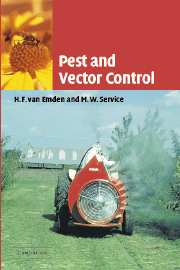Book contents
- Frontmatter
- Contents
- Preface
- 1 Man and insects
- 2 The causes of pest and vectored disease outbreaks
- 3 Insecticides and their formulation
- 4 Application of insecticides
- 5 Problems with insecticides
- 6 Environmental/cultural control
- 7 Biological control
- 8 Insect pathogens
- 9 Genetic control
- 10 Pheromones
- 11 Plant and host resistance
- 12 Other control measures and related topics
- 13 Pest and vector management
- Appendix of names of some chemicals and microbials used as pesticides
- References
- Index
12 - Other control measures and related topics
Published online by Cambridge University Press: 03 December 2009
- Frontmatter
- Contents
- Preface
- 1 Man and insects
- 2 The causes of pest and vectored disease outbreaks
- 3 Insecticides and their formulation
- 4 Application of insecticides
- 5 Problems with insecticides
- 6 Environmental/cultural control
- 7 Biological control
- 8 Insect pathogens
- 9 Genetic control
- 10 Pheromones
- 11 Plant and host resistance
- 12 Other control measures and related topics
- 13 Pest and vector management
- Appendix of names of some chemicals and microbials used as pesticides
- References
- Index
Summary
Introduction
The problems of the continued widespread use of pesticides, and particularly the absorption of the words ‘environmental pollution’ into common vocabulary, have caused scientists to look seriously at any ideas for pest/vector control which do not involve traditional insecticides. Although the preceding chapters have discussed those control approaches which have the widest general application, there are several other methods which are, or have been, in use or have been proposed.
In this chapter we bring together this variety of unrelated methods which do not warrant a separate chapter of their own. The ingenuity of mankind in inventing ways of tackling insect problems has led to a huge variety of such methods, and we cannot pretend we can make this chapter comprehensive.
We conclude this chapter on ‘Other control methods’ in a different vein – attempts legally to enforce control practices (‘Legislative controls’), and finally we raise some ‘Other topics’ which do not directly lead to the control of insects but which we believe are relevant to the topics covered in this book and should be included.
Physical methods
Such controls aim to reduce insect populations by using devices which affect them physically or alter their physical environment. Some may be hardly distinguishable from environmental or cultural controls and are frequently labour-intensive. For example, in the early days of pest control in developing countries, handpicking and foot-crushing of larger insects (e.g. caterpillars) was economically viable and effective.
- Type
- Chapter
- Information
- Pest and Vector Control , pp. 242 - 270Publisher: Cambridge University PressPrint publication year: 2004



